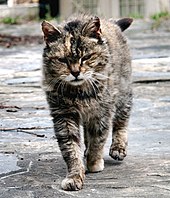Farm cat
This article needs additional citations for verification. (April 2011) |

Archeological evidence suggests that the earliest domestication of cats was motivated by the human need to safeguard grain stores from rodent pests.[1] Today farm cats, also known as barn cats, are still commonly kept for the purpose of catching the smaller vermin found on farms and ranches, which would otherwise eat and/or contaminate crops, especially grain or feed stocks.
Though farm cats may have a more wild temperament than cats kept as pets, they may be treated as house cats or derive sustenance solely from their job of lowering the mouse and rat populations. In the latter case, lack of guaranteed food supply, and the necessity of physical exertion on their part, may tend to make these cats much leaner than their domestic counterparts.
If the population of adult female farm cats is kept high enough (about 3–6 breeding females, depending on the location) their population can be self-sustaining for several years. The females establish permanent homes in barns or other structures, especially if they are fed and sheltered there. Males almost always leave permanently, only returning to mate. This can lead to inbreeding, as the male offspring return to impregnate their mothers. Spaying and neutering prevent unwanted litters and inbreeding.
In areas with high numbers of predators, barn cat populations often become extirpated. They can be eaten by raccoons, owls, coyotes, and other animals that prey on creatures of their size.
In the past, farmers controlled their farm cat population by selling cats to scientific or medical organizations. Carolina Biological used to collect excess farm cats for sale as dissection specimens, but this practice has long been abandoned.[citation needed]
References
External links
